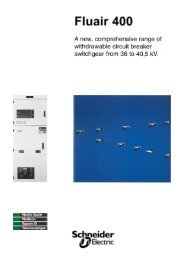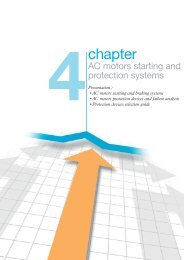Connect - Schneider Electric
Connect - Schneider Electric
Connect - Schneider Electric
You also want an ePaper? Increase the reach of your titles
YUMPU automatically turns print PDFs into web optimized ePapers that Google loves.
2 SUSTAINABLE DEVELOPMENT<br />
GREEN AND RESPONSIBLE GROWTH DRIVING ECONOMIC PERFORMANCE<br />
52<br />
> 2. Green and responsible growth<br />
driving economic performance<br />
This chapter covers two subjects:<br />
• Products and solutions for fighting climate change: energy<br />
effi ciency, renewable energies, electric vehicles, smart grid,<br />
product end-of-life recovery services , etc.<br />
• Business ethics: Group responsibility principles, fi ght against<br />
corruption, relations with suppliers and subcontractors.<br />
2.1 Overview<br />
Context and aims<br />
Climate change is one of the main challenges of the 21st century.<br />
<strong>Schneider</strong> <strong>Electric</strong> works for sectors that account for the majority<br />
of global energy consumption. Energy consumption is not always<br />
optimised, which makes it one of the largest sources of CO2 emissions.<br />
As a global specialist in energy management, <strong>Schneider</strong> <strong>Electric</strong>’s<br />
products and solutions help reduce energy use and CO emissions.<br />
2<br />
The Group is therefore developing energy effi ciency solutions to<br />
reduce energy bills by up to 30% for every type of building. The<br />
Group’s solutions also target other areas related to intelligent<br />
electricity networks (Smart Grids): generation and connection to the<br />
renewable energies grid; electric vehicles; and demand-response.<br />
REGISTRATION DOCUMENT 2011 SCHNEIDER ELECTRIC<br />
Corporate governance is discussed in chapter 3 “Corporate<br />
Governance” page 107 : working of the Supervisory Board,<br />
Management Board, Internal Control & Audit, shareholders’ rights,<br />
remuneration of members of the Supervisory Board, Management<br />
Board and Executive Committee.<br />
Moreover, the Group’s products and solutions are sold worldwide,<br />
either directly to end customers or through networks of partners,<br />
therefore without any control over their fi nal destination and endof-life<br />
processing. To limit the impact of its end-of-life products,<br />
<strong>Schneider</strong> <strong>Electric</strong> has established a system to recover equipment<br />
containing SF , a powerful greenhouse gas.<br />
6<br />
The Group works in more than 100 countries, with uniform practices,<br />
standards and values. <strong>Schneider</strong> <strong>Electric</strong> is also committed to act<br />
responsibly towards all of its stakeholders. Therefore, the Company<br />
has defi ned its Principles of Responsibility that apply to the whole<br />
Group and are based on dedicated organisation and processes.<br />
<strong>Schneider</strong> <strong>Electric</strong> has also been involved in the United Nations<br />
Global Compact since 2002, which it wishes to encourage a larger<br />
number of its suppliers to sign.<br />
Four key performance indicators were set in <strong>Schneider</strong> <strong>Electric</strong>’s Planet & Society Barometer over the duration of the One program<br />
(2009- 2011):<br />
Objectives for Year-End-2011 2011 2010 2009 2008<br />
1. Exceeding the Group’s growth by 7 points per year<br />
with our energy effi ciency activities 14.2 ▲ 8.3 5.3 NM<br />
2. Implement a recovery process for SF gas 6<br />
in 10 countries<br />
3. Make 60% of our purchases from suppliers who<br />
8 3 3 0<br />
support the Global Compact<br />
4. Ensure that 4 major ethical stock indices select<br />
50.4% ▲ 42% 33% 30%<br />
<strong>Schneider</strong> <strong>Electric</strong><br />
NM = Indicator not monitored<br />
3 ▲ 2 3 3<br />
The 2008 performance serves as a starting value for the Planet & Society Barometer of the One program between 2009 and 2011.<br />
▲ 2011 Audited Indicators<br />
Please refer to pages 90 to 92 for the methodological presentation of indicators and the following pages for the analysis of the results<br />
(pages 53-54 for indicator 1, 55-56 for indicator 2, 56-57 for indicator 3, 51 for indicator 4 ).

















